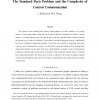Free Online Productivity Tools
i2Speak
i2Symbol
i2OCR
iTex2Img
iWeb2Print
iWeb2Shot
i2Type
iPdf2Split
iPdf2Merge
i2Bopomofo
i2Arabic
i2Style
i2Image
i2PDF
iLatex2Rtf
Sci2ools
CDC
2009
IEEE
2009
IEEE
The standard parts problem and the complexity of control communication
The objective of the standard parts optimal control problem is to find a number, m, of control inputs to a given input-output system that can be used in different combinations to achieve a certain number, n, of output objectives and to do this in such a way that a specified figure-of-merit measuring the average cost of control is minimized. The problem is especially interesting when m is significantly less than n. Distributed optimization problems of this type arise naturally in connection with recent work on control communication complexity. In what follows a general formulation of the standard parts optimization problem is given along with some simple illustrative examples. Control communication complexity is defined, and it is shown how one measure of this complexity naturally leads to a standard parts optimization problem. The entire circle of ideas is explored in the context of quadratic optimal control of the Heisenberg system, and recent results on computability using simp...
CDC 2009 | Control Communication Complexity | Control Systems | Optimization Problem | Standard Parts |
| Added | 21 Jul 2010 |
| Updated | 21 Jul 2010 |
| Type | Conference |
| Year | 2009 |
| Where | CDC |
| Authors | John Baillieul, Wing Shing Wong |
Comments (0)

